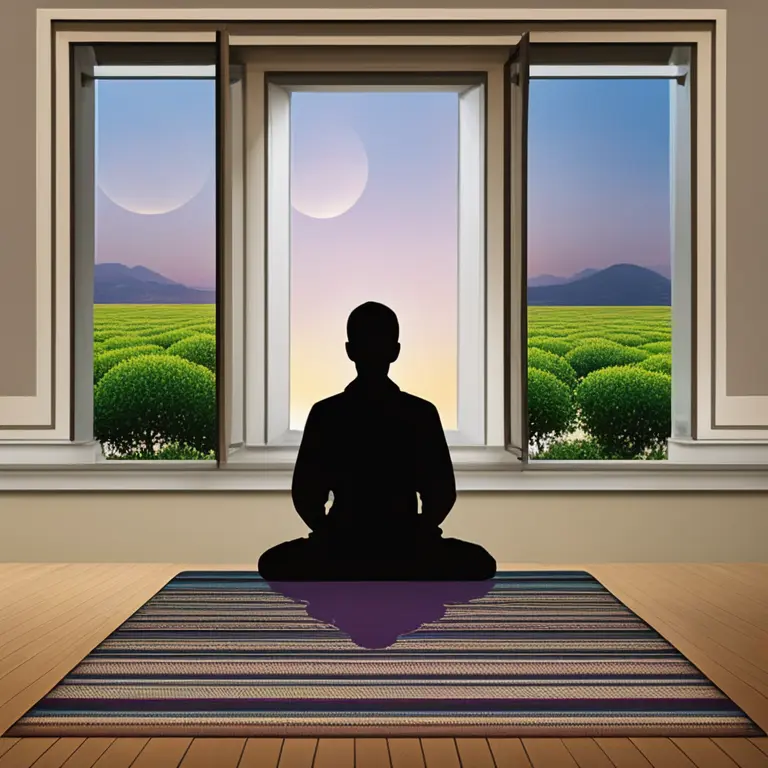
Eyes Open Meditation: A Different Approach to Mindfulness
Discover the art of meditating with your eyes open, a practice that integrates mindfulness into the flow of everyday life.
article by Hina Kurosawa
The Basics of Open-Eye Meditation
Meditation often conjures up images of closed eyes and quiet spaces, but the practice of open-eye meditation expands this vision. This technique allows practitioners to engage with the world around them while still maintaining a meditative state. Instead of withdrawing from our surroundings, open-eye meditation teaches us to remain present and attentive to the moment. By keeping our gaze soft and unfocused, we can cultivate awareness that harmonizes our inner and exterior worlds, offering a seamless transition between meditation and daily life.

Benefits and Applications
Adopting an eyes-open approach provides tangible benefits. It can improve our ability to stay present during everyday tasks and strengthen our focus. Moreover, this form of meditation can be particularly useful for individuals who struggle to close their eyes due to anxiety or traumatic experiences. By integrating meditation into various actions, such as walking or engaging in art, we foster mindfulness that is active rather than passive, creating a resilient, adaptable mindset for the challenges of the modern world.

Getting Started with Eyes Wide Open
For those new to eyes-open meditation, the initial step is finding a quiet space with minimal distractions. Begin by sitting comfortably, softening your gaze, and looking at a point on the floor several feet in front of you. It's important to let your eyes rest in a relaxed manner, avoiding a hard focus on any particular object. As you adapt to this practice, you can gradually introduce it into more dynamic environments, training your mind to carry a meditative quality into all aspects of your life.

Challenges and Considerations
Open-eye meditation can come with its own set of challenges. Dealing with distractions is a major one, as the world around us doesn't stop moving. However, these challenges are part of the learning curve. They encourage us to develop greater mental resilience and adaptability. It's essential to approach this practice with patience and understand that proficiency will come with time and consistent practice. Remember, the goal is not to eliminate distractions but to find peace and presence amidst them.

Integrating Meditation into Daily Routines
As our proficiency grows, we can start weaving meditation into our daily routines. This could be during moments as simple as enjoying a cup of coffee in the morning or waiting in line at the grocery store. Eventually, open-eye meditation can become a constant backdrop to our lives, helping us remain grounded and centered in a fast-paced, constantly changing world.
Advancing Your Practice
For those looking to deepen their practice, specific adjustments can be made. Adjusting the field of vision to include more of your environment or engaging in open-eye meditations in nature can expand your mindfulness. Engaging with complex visual stimuli, such as moving water or leaves rustling in the wind, can also become part of a more advanced practice. As you evolve, consider attending workshops or seeking guidance from experienced practitioners to explore the full depth of open-eye meditation.
Published: 1/24/2024
Modified: 1/24/2024
More predictions
Come back here soon to learn more about yourself and your future


Simple Guide to Meditation Practices
Meditation made easy for beginners – discover simple techniques to start your mindfulness journey.


Soothing Sleep: Meditation for Restful Nights
Discover effective meditation practices to enhance sleep quality and embrace restfulness in this insightful article.


Meditation Techniques for Individuals With ADHD
Discover effective meditation practices tailored for individuals with ADHD to improve focus, reduce hyperactivity, and foster a sense of calm.